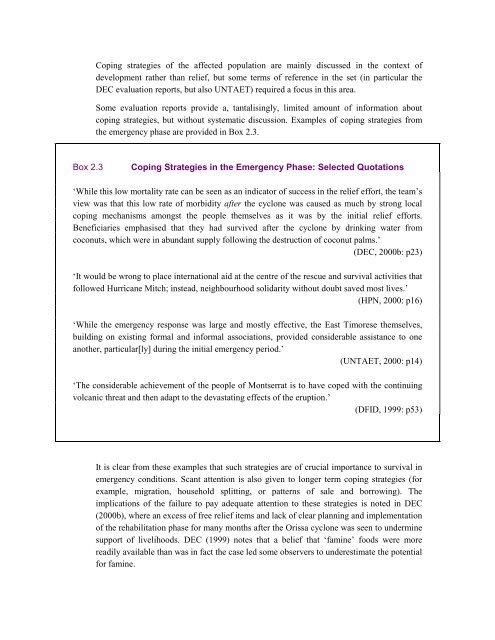Download PDF - ReliefWeb
Download PDF - ReliefWeb
Download PDF - ReliefWeb
You also want an ePaper? Increase the reach of your titles
YUMPU automatically turns print PDFs into web optimized ePapers that Google loves.
Coping strategies of the affected population are mainly discussed in the context of<br />
development rather than relief, but some terms of reference in the set (in particular the<br />
DEC evaluation reports, but also UNTAET) required a focus in this area.<br />
Some evaluation reports provide a, tantalisingly, limited amount of information about<br />
coping strategies, but without systematic discussion. Examples of coping strategies from<br />
the emergency phase are provided in Box 2.3.<br />
Box 2.3 Coping Strategies in the Emergency Phase: Selected Quotations<br />
‘While this low mortality rate can be seen as an indicator of success in the relief effort, the team’s<br />
view was that this low rate of morbidity after the cyclone was caused as much by strong local<br />
coping mechanisms amongst the people themselves as it was by the initial relief efforts.<br />
Beneficiaries emphasised that they had survived after the cyclone by drinking water from<br />
coconuts, which were in abundant supply following the destruction of coconut palms.’<br />
(DEC, 2000b: p23)<br />
‘It would be wrong to place international aid at the centre of the rescue and survival activities that<br />
followed Hurricane Mitch; instead, neighbourhood solidarity without doubt saved most lives.’<br />
(HPN, 2000: p16)<br />
‘While the emergency response was large and mostly effective, the East Timorese themselves,<br />
building on existing formal and informal associations, provided considerable assistance to one<br />
another, particular[ly] during the initial emergency period.’<br />
(UNTAET, 2000: p14)<br />
‘The considerable achievement of the people of Montserrat is to have coped with the continuing<br />
volcanic threat and then adapt to the devastating effects of the eruption.’<br />
(DFID, 1999: p53)<br />
It is clear from these examples that such strategies are of crucial importance to survival in<br />
emergency conditions. Scant attention is also given to longer term coping strategies (for<br />
example, migration, household splitting, or patterns of sale and borrowing). The<br />
implications of the failure to pay adequate attention to these strategies is noted in DEC<br />
(2000b), where an excess of free relief items and lack of clear planning and implementation<br />
of the rehabilitation phase for many months after the Orissa cyclone was seen to undermine<br />
support of livelihoods. DEC (1999) notes that a belief that ‘famine’ foods were more<br />
readily available than was in fact the case led some observers to underestimate the potential<br />
for famine.
















![CynefinFramework final [Read-Only]](https://img.yumpu.com/19017304/1/190x135/cynefinframework-final-read-only.jpg?quality=85)